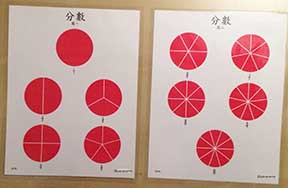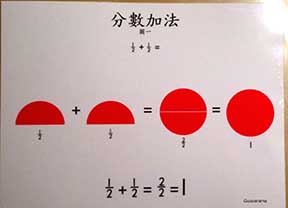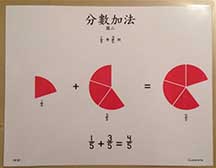Update: I figured out how to make the fraction charts 6 months later. Here’s my post and pics of the final charts as well as the actual charts in PDF format for both English and Chinese.
After about two weeks desponding over my incomprehension of using work plans, kids speeding through materials in 15 minutes, and a month of not really making new materials, I jumped back into fraction work. Anything to keep my mind of my hated 3 hour work period (I semi-jest). Early November, Thumper was introduced to the fraction insets. She got the concept of naming fractions in both Chinese and English in about 10 minutes. I somehow convinced her to do a fractions match-up activity borrowed from What Did We Do All Day for about 10 minutes. She dragged her feet. Then the last 3 weeks we’ve been doing fraction equivalence; 1 page a week. I feel like I’m pulling teeth. But I will leave my moping for another day. This week, I thought I would mix things up by introducing fraction addition. But first I have to make those Fraction Charts. According to my album, there are 21 charts. They are not impressionistic as they’re more for reference, and therefore do not need to be big. I cross referenced with What Did We Do Today and Montessori School At Home, and my own album. I still don’t get what some of the charts should be. My album says one thing, the charts online say another. I’m going to wait till my class this Spring to ask the prof.
- Chart 1 & 2 – Fraction circles
- Chart 3, 4, 5 – Equivalence for 1/2, 1/3, 1/4, 1/5
- Chart 6 – Addition with same denominator, ending with whole number
- Chart 7 – Addition with same denominator, ending with fractions
- Chart 8 – 12 – Not sure
- Chart 13 – Subtracting with different denominators
- Chart 14 – Multiplication with whole number
- Chart 15 – Multiplication with whole number, with rule
- Chart 16 – Multiplication of whole number with fraction and fraction with fraction
- Chart 17 – Multiplication of fraction with fraction, with rule
- Chart 18 – Division with whole number
- Chart 19 – Division with whole number, with rule
- Chart 20 – Group Division
- Chart 21 – Division of fraction with fraction
The two blogs I referenced had colored fractions. I chose not to do so because if some of fraction work is about equivalence, then it didn’t make sense to me to have them in different colors. How can one color equal to another color? I will try it on Thumper and see. It is so much easier to find the right fraction though when it’s color coded. On top of that, all the fraction circle materials are not color coded.

My trainer once told me that it is perfectly okay, and in fact super great, to have the children help with prep work. Since Thumper was not liking the tediousness of finding equivalent fractions and writing them on a research page, I had her help me with Charts 3, 4, 5. She had to cut out the equivalent fractions and glue them on. I then laminated them. One question I had was the congruence sign on the online charts. Another question to ask my trainer as I don’t understand why we use a congruence symbol, is it because the shapes are the same? Other changes I made to the online charts were:
- Making all the fractions be on top for equivalence charts
- Changing Chart 7 so that the fraction placement match the final answer
- Changing Chart 6 so it looks like an equation like the rest of the charts.




I then got REALLY stuck after that. I did not think the chart intuitive in depicting “subtraction” and needed a way to show the “take away” fraction circle instead of just writing the numbers. But can’t figure out how to do so in Illustrator. I skipped ahead to multiplication and got double stuck with the second rule of multiplying by whole numbers. The rule is this: When multiplying fraction with whole number, multiply numerator by whole number, OR, if divisible, divide the denominator by the whole number. WHA? First we’re multiplying and now dividing? How do you explain that to a kid? Tonight, Baba and I argued discussed it for 1.5 hours and couldn’t reach any conclusion. I understand the reasoning for it but did not understand why they explained it as a pure division of two numbers. After 1.5 hours my conclusion was that you cannot quite illustrate it with fraction circles, and if so, why put it in there? Is it because by then (3rd grade) you’re really working with abstractions? In any case, I remember it more as a reduction of both numerator and denominator. All the websites I checked in Taiwan introduced the concept of multiplying by whole numbers as whole number over 1. And then it’s just a simple matter of multiplying numerator with numerator, denominator with denominator. Looking at curriculum, I see that for first grade, you do:
- intro to fraction
- equivalence
- fraction simple operation (add/subtract same denominator, mul/div whole numbers)
- addition & subtraction of fractions with different denominator.
So, I’m going to abandon ship and just make the charts I need for now. I want the charts to be a good reference, but this requires thinking of how I would change the charts, and that usually takes lots of research on how other people do it. At the same time, I feel like then it’s not “authentic Montessori” enough though I KNOW that it makes no sense logically. So far, I’ve made 7 charts out of 21 after 2 days. Sometimes I’m not sure if it’s easier to just do things by hand rather than drawing on the computer!
